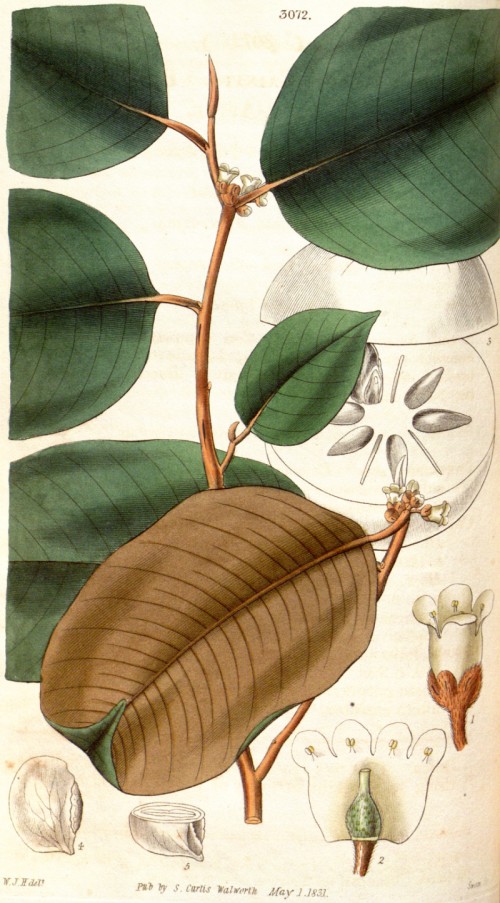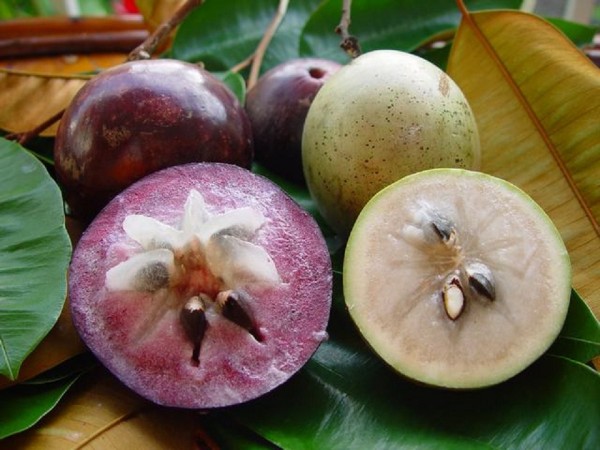Benutzer-Werkzeuge
Dies ist eine alte Version des Dokuments!
Chrysophyllum cainito L. - Sapotaceae - star apple, caimito tree, caimito (span.), Sternapfel
Evergreen tree, up to 20m high, native to Central America, naturalized and cultivated in Caribbean and Southeast Asia; leaves alternate, oblong-elliptic to oblanceolate-elliptic, entire, upper side glabrous, abaxially golden-brown; flowers tiny, purplish white, sweet fragrant; fruit globose, usually purple to black (or red, brown, greenish-yellow). The edible fruit pulp is white, soft, and milky.
„The fruits are delicious as a fresh dessert fruit; it is sweet and best served chilled. Infusions of the leaves have been used against diabetes and articular rheumatism. The fruit has anti-oxidant properties. The bark is considered a tonic and stimulant, and a bark decoction is used as an antitussive.“
http://en.wikipedia.org/wiki/Chrysophyllum_cainito
Of the 104 compounds identified in the aroma concentrate from C. cainito fruits growing in Cuba, major constituents were (E)-2-hexenal, 1-hexanol, limonene, linalool, α-copaene and hexadecanoic acid. „The presence of many terpenic compounds is thought to contribute to the unique flavour of the star apple fruit.“
[Volatile constituents of star apple (Chrysophyllum cainito L.) from Cuba., Pino, J., Marbot, R., Rosado, A., Flavour and fragrance journal, Vol.17(5), 2002, 401-403]
The fruits contain polyphenolic antioxidants, mainly (−)-epicatechin, but also (+)-catechin, (+)-gallocatechin, (−)-epigallocatechin, quercetin, quercitrin, isoquercitrin, myricitrin, and gallic acid.
[Polyphenolic antioxidants from the fruits of Chrysophyllum cainito L.(star apple)., Luo, X.D., Basile, M.J., Kennelly, E.J., Journal of agricultural and food chemistry, Vol.50(6), 2002, 1379-1382]
„Chrysophyllum cainito is most closely related to a clade containing Central and South American C. argenteum, including subsp. panamense. We hypothesize that caimito is native to southern Mesoamerica and was domesticated from multiple wild populations in Panama. Subsequent migration into northern Mesoamerica and the Antilles was mediated by human cultivation.“
[Origins and close relatives of a semi-domesticated neotropical fruit tree: Chrysophyllum cainito (Sapotaceae)., Petersen, J.J., Parker, I.M., Potter, D., American journal of botany, Vol.99(3), 2012, 585-604]
Main sugars (330mg/g d.w.) of ripe fruits from Thailand were maltose (113mg/g), glucose (99mg/g), and fructose (117mg/g).
[Phytochemicals, vitamin C and sugar content of Thai wild fruits., Kubola, J., Siriamornpun, S., Meeso, N., Food Chemistry, Vol.126(3), 2011, 972-981]
http://www.thaiscience.info/Article%20for%20ThaiScience/Article/1/Ts-1%20phytochemicals,%20vitamin%20c%20and%20sugar%20content%20of%20thai%20wild%20fruits.pdf

Curtis’s Botanical Magazine, vol. 58 [ser. 2, vol. 5]: t. 3072 (1831) [W.J. Hooker]
http://plantgenera.org/species.php?id_species=240774

picture source Zoom's Edible Plants
